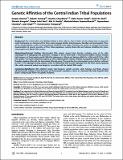Por favor, use este identificador para citar o enlazar a este item:
http://hdl.handle.net/10261/67311COMPARTIR / EXPORTAR:
 SHARE SHARE
 CORE
BASE CORE
BASE
|
|
| Visualizar otros formatos: MARC | Dublin Core | RDF | ORE | MODS | METS | DIDL | DATACITE | |

| Título: | Genetic affinities of the central Indian tribal populations |
Autor: | Sharma, G.; Tamang, R.; Chaudhary, R.; Singh, V.K.; Shah, A.M.; Anugula, S.; Rani, D.S.; Reddy, A.G.; Eaaswarkhanth, M.; Chaubey, G.; Singh, L.; Thangaraj, K. | Fecha de publicación: | 2012 | Editor: | Public Library of Science | Citación: | PLoS ONE 7 (2012) | Resumen: | Background: The central Indian state Madhya Pradesh is often called as 'heart of India' and has always been an important region functioning as a trinexus belt for three major language families (Indo-European, Dravidian and Austroasiatic). There are less detailed genetic studies on the populations inhabited in this region. Therefore, this study is an attempt for extensive characterization of genetic ancestries of three tribal populations, namely; Bharia, Bhil and Sahariya, inhabiting this region using haploid and diploid DNA markers. Methodology/Principal Findings: Mitochondrial DNA analysis showed high diversity, including some of the older sublineages of M haplogroup and prominent R lineages in all the three tribes. Y-chromosomal biallelic markers revealed high frequency of Austroasiatic-specific M95-O2a haplogroup in Bharia and Sahariya, M82-H1a in Bhil and M17-R1a in Bhil and Sahariya. The results obtained by haploid as well as diploid genetic markers revealed strong genetic affinity of Bharia (a Dravidian speaking tribe) with the Austroasiatic (Munda) group. The gene flow from Austroasiatic group is further confirmed by their Y-STRs haplotype sharing analysis, where we determined their founder haplotype from the North Munda speaking tribe, while, autosomal analysis was largely in concordant with the haploid DNA results. Conclusions/Significance: Bhil exhibited largely Indo-European specific ancestry, while Sahariya and Bharia showed admixed genetic package of Indo-European and Austroasiatic populations. Hence, in a landscape like India, linguistic label doesn't unequivocally follow the genetic footprints. © 2012 Sharma et al. | URI: | http://hdl.handle.net/10261/67311 | DOI: | 10.1371/journal.pone.0032546 | Identificadores: | doi: 10.1371/journal.pone.0032546 issn: 1932-6203 |
| Aparece en las colecciones: | (EBD) Artículos |
Ficheros en este ítem:
| Fichero | Descripción | Tamaño | Formato | |
|---|---|---|---|---|
| journal.pone.0032546.pdf | 727,72 kB | Adobe PDF |  Visualizar/Abrir |
CORE Recommender
PubMed Central
Citations
13
checked on 04-abr-2024
SCOPUSTM
Citations
27
checked on 17-abr-2024
WEB OF SCIENCETM
Citations
24
checked on 25-feb-2024
Page view(s)
371
checked on 18-abr-2024
Download(s)
242
checked on 18-abr-2024
Google ScholarTM
Check
Altmetric
Altmetric
Artículos relacionados:
NOTA: Los ítems de Digital.CSIC están protegidos por copyright, con todos los derechos reservados, a menos que se indique lo contrario.
